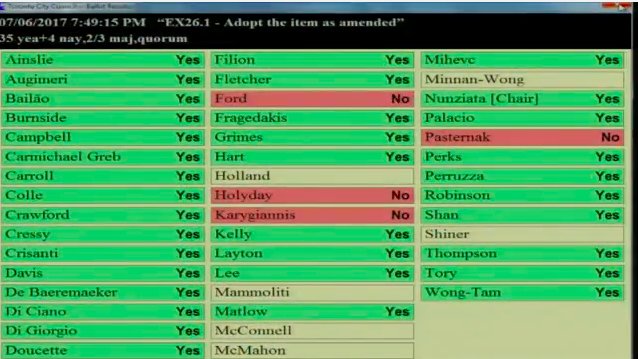City council gave the green light to a pilot project aimed at improving streetcar service on King St., but under pressure from the taxi industry, councillors agreed to alter the plan and exempt cabs from the project’s traffic restrictions at certain times of night.
After a four-hour debate, council voted 35 to 4 on Thursday to go ahead with the pilot project on a 2.6-kilometre stretch of King, between Bathurst and Jarvis Streets.
The pilot will be implemented this fall.
It will last for at least one year. During that time, there will be no through-traffic allowed for private motor vehicles on King. Instead, cars will be forced to turn right at the end of major blocks. Left turns will also be prohibited.
The traffic reconfiguration and modifications to the street are expected to make service on the 504 King streetcar more efficient. The line carries 65,000 people every day and is the TTC’s busiest surface route.
But in a last-minute amendment seen as a compromise aimed at winning over the pilot’s council critics, Mayor John Tory moved to exempt taxis from the prohibition on through-traffic between the hours of 10 p.m. to 5 a.m. The motion passed 38 to 1.
“There’s no question in my mind, and, I think, many of the minds in this room, that the cab industry does represent an important part of the overall transportation system to get people around, especially at that time of night in that part of town,” said Tory in a speech to council.
Tory said his motion, which also instructed staff to double the number of planned taxi stands, would improve the pilot, which he praised as “something that a 21st Century city must do to move people effectively and to protect the livability and the economy of the city.”
The exemption will only apply to licensed cabs. Uber and other ride-sharing services will have to follow the rules.
The amendment came despite the objections of TTC CEO Andy Byford and a report from city transportation staff that recommended against giving taxis special consideration.
Byford told councillors that King, which crosses through the heart of the downtown entertainment district, is busy even into the small hours of the morning. “Which is why we’re saying, from a TTC perspective, don’t water this down. Let’s keep the pressure on, because the streetcars still struggle to get through even late at night,” he said.
A report from transportation staff published on Wednesday warned that exempting taxis from the rules might “undermine the transit-first objective of the pilot project.”
The report recommended against an overnight exemption, noting that average speeds for streetcars between 10 p.m. and 2 a.m. are between 4.6 and 6.8 km/hr. It said that while giving special consideration to cabs could help disperse nightlife crowds on King, it could “add complexity” to the project and potentially confuse other drivers, “resulting in reduced compliance” with the pilot rules.
Asked whether the watered-down version of the pilot could truly be considered a bold move to improve transit, Councillor Joe Cressy, a vocal supporter of the project that will run through his ward, replied that if the taxi exemption didn’t work, council can re-evaluate it.
“It’s radical incrementalism, as we do it in Toronto,” said Cressy (Ward 20 Trinity-Spadina).
Sam Moini, President, Toronto Fleet Operators Association, said the taxi industry was hoping for a 24-hour exemption, “but you’ve got to get what you can get.”
“The council did recognize that we’re an integral part of the transit system, especially in the evening,” he said.
The city revealed the latest in a series of efforts to unclog one of downtown’s major thoroughfares.
According to city reports the 504 King streetcar is so impeded by traffic that its service is “slow, unreliable, and erratic,” and walking is often faster. Currently private cars take up most of the space on the street, but carry only 20,000 people a day, less than a third of the ridership of the streetcar line.
In addition to the turning restrictions, during the pilot, King St. will be reduced from two lanes in each direction to one, with the curb lane reserved for streetcar boarding zones, public space, and areas for loading, deliveries, and taxis.





